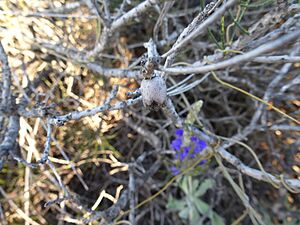Claw flower facts for kids
Quick facts for kids Claw flower |
|
|---|---|
 |
|
| Calothamnus chrysanthereus growing on Red Bluff near Kalbarri | |
| Scientific classification | |
| Genus: |
Calothamnus
|
| Species: |
chrysanthereus
|
The Claw Flower (Calothamnus chrysanthereus) is a unique plant. It belongs to the myrtle family, called Myrtaceae. This plant grows only in the southwest part of Western Australia. It's a type of shrub that stands upright. Its branches have many thin, needle-like leaves. In spring, it shows off bright red flowers. Some scientists suggested changing its name to Melaleuca chrysantherea in 2014.
Contents
What Does the Claw Flower Look Like?
The Claw Flower is a shrub that can stand tall or spread out. It usually grows to about 1.5 metres (5 ft) high. Older branches have a special corky bark. Its leaves are packed together at the ends of the branches. They look like needles, about 50–90 millimetres (2–4 in) long. These leaves are round and pointy at the end.
Claw Flower Blooms and Fruits
The flowers grow in groups or loose spikes. You can find up to 10 flowers together. They often appear on older stems that have lost their leaves. Each flower has five papery petals, about 3–5 millimetres (0.1–0.2 in) long. The most striking part is the bright red stamens. These are arranged in 5 bundles that look like claws. Each bundle has 24 to 28 stamens.
Claw Flowers bloom from August to December. After the flowers, the plant grows woody fruits. These fruits are called capsules. They are about 12–15 millimetres (0.5–0.6 in) long.
How Did the Claw Flower Get Its Name?
The Claw Flower was first officially described in 1862. A scientist named Ferdinand von Mueller wrote about it. He published his findings in a book called Fragmenta Phytographiae Australiae. Later, in 1867, George Bentham gave it the full name Calothamnus chrysantherus. In 2010, another scientist, Alex George, brought back the name Calothamnus chrysanthereus.
Where Does the Claw Flower Grow?
This special plant is common in the heathlands. You can find it north of Geraldton in Western Australia. It grows in areas known as the Geraldton Sandplains and Yalgoo. The Claw Flower likes sandy soil and can grow in many different places.
Is the Claw Flower in Danger?
The Western Australian government's Department of Parks and Wildlife checks on plants. They have classified Calothamnus chrysanthereus as "not threatened." This means it is not currently in danger of disappearing.



